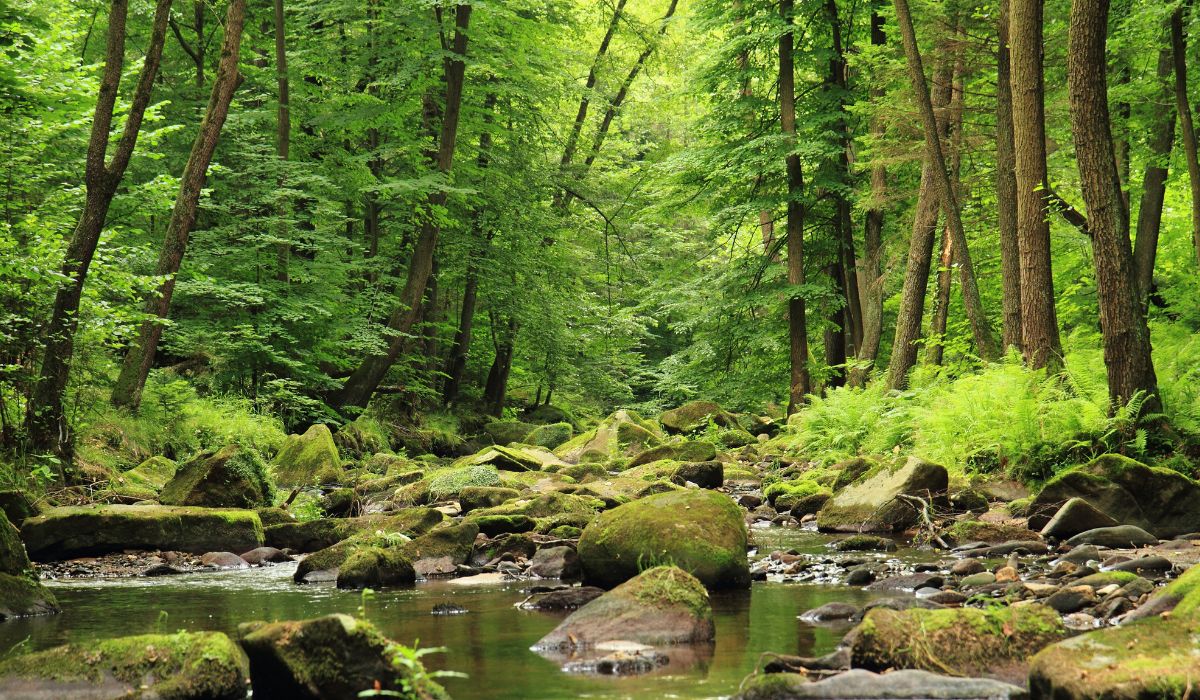Trees talk, forests walk, and soil stores more carbon than the atmosphere! Discover incredible forest facts that will change how you see these ecosystems.
Forests cover about 31 percent of our planet’s land area, and they make life on Earth possible in many ways. Despite the vital importance of these ecosystems, most people only scratch the surface when it comes to understanding them. These natural wonderlands hold secrets that would blow your mind—from trees that communicate with each other to forests that can literally walk across landscapes over time.
Ready to have your perspective on forests completely transformed? Let’s explore some facts about forests that will wow nature lovers like yourself and make your next wooded walk all the more special.
Trees Talk to Each Other Through Underground Networks
The forest floor might look quiet, but beneath your feet lies one of nature’s most sophisticated communication systems. Trees connect through a vast underground network of fungal threads called mycorrhizae. Scientists have humorously (and accurately) dubbed this network the “wood wide web.”
According to Science Magazine, mycorrhizae allow trees to share nutrients, water, and warning signals about insect attacks, diseases, and other threats. In fact, mother trees can recognize their own seedlings and send them more resources through this network. Some trees even release chemical signals through the air to warn neighboring trees about incoming threats, causing them to boost their natural defenses before danger arrives.
Scientists have discovered that older, larger trees act like hub nodes in this network, similar to major servers on the Internet (hence, the nickname “wood wide web”). They can be connected to hundreds of other trees, sharing resources and information across the entire forest community.
Some Forests Can Actually Walk
Though trees don’t walk like they do in The Lord of the Rings, you might be surprised to learn that walking palm trees exist. This species (Socratea exorrhiza) doesn’t run across fields or launch rocks with woody tendrils, but it can relocate itself via its roots. The process is slow, taking several years to complete. But in the Sumaco Biosphere Reserve in Ecuador, these walking palm trees are literally moving across the forest floor, “walking” up to 20 meters per year.
This movement helps the trees chase sunlight as the forest canopy changes or escape from obstacles that might be blocking their growth.
Forests Create Their Own Weather
Large forests don’t just respond to weather—they actually create it. For example, this article from National Geographic recognizes how rainforests generate roughly half (and even up to 75 percent!) of their own rainfall through a process called evapotranspiration. How does this work? Trees release water vapor through their leaves, which rises into the atmosphere and forms clouds that eventually rain back down on the forest.
This process creates a self-sustaining cycle that can influence weather patterns hundreds of miles away. When large areas of forest are removed, the local climate can change dramatically, often becoming drier and more prone to extreme temperatures.
Forest Soils Hold More Carbon Than the Atmosphere
Most people think of trees as the main carbon storage units in forests, but forest soils actually contain more carbon than the atmosphere and all plant life combined through a process called soil-based carbon sequestration. These soils can store carbon for thousands of years, making them crucial in the fight against climate change.
Even just the top meter of forest soil worldwide contains about 1,500 billion tons of carbon—roughly three times more than what’s currently in the atmosphere. This makes forest conservation and restoration one of the most effective strategies for reducing atmospheric carbon dioxide levels.
Ancient Trees Are Living Time Machines
Some trees alive today were already ancient when human civilization began. You may have heard about Methuselah, a Great Basin bristlecone pine in California’s White Mountains that, at over 5,000 years old, is the oldest known tree. To give you some perspective, this tree was already about 1,000 years old when the pyramids were built in Egypt.
These ancient trees serve as living libraries, storing information about historical climate conditions in their growth rings. Scientists can read these rings like pages in a book to learn about droughts, volcanic eruptions, and climate patterns from thousands of years ago. Even more incredible, some of these ancient trees continue to grow and reproduce, producing viable seeds after millennia of life.
Forests Are Home to Incredible Biodiversity
Tropical rainforests cover just about 2–6 percent of Earth’s surface but contain more than 50 percent of all known plant and animal species, according to National Geographic. That’s incredible, isn’t it? For instance, a single tree in the Amazon rainforest can host thousands of insect species!
Scientists estimate that at least thousands of species in forests remain undiscovered. Every year, researchers identify hundreds of new species in forest environments, from tiny insects to colorful birds and unique plants with potential medicinal properties.
Some forest ecosystems are so specialized that species exist nowhere else on Earth. These endemic species have evolved specifically for their particular forest environment and cannot survive anywhere else. An example is the odd-looking, snout-sporting purple frog endemic to the Western Ghats of India.
Forests Have Healing Powers
Spending time in forests provides measurable health benefits beyond just fresh air and exercise. Just standing in a forest and immersing yourself in the atmosphere has been scientifically proven to reduce stress hormones, lower blood pressure, and boost immune system function.
Trees release chemicals called phytoncides, which we can absorb when walking through forests. These natural compounds have antimicrobial properties and can increase the activity of natural killer cells (a type of white blood cell that attacks threats) in our immune systems.
Forests Are Nature’s Water Filters
Forests act like giant water treatment plants, filtering and purifying water as it moves through the ecosystem. Tree roots and forest soils remove pollutants, excess nutrients, and sediments from water before it reaches streams, rivers, and groundwater supplies.
The root systems of forest trees also prevent soil erosion, keeping valuable topsoil in place and preventing it from washing into water bodies. This natural filtration system is so effective that many cities rely on forested watersheds to provide clean drinking water for millions of people, per the US Forest Service.
Forests Can Benefit From Our Management Efforts
As we have already proved, forests are essential for protecting biodiversity, storing carbon, and maintaining ecosystems, but they must be healthy to do so. Human involvement is a double-edged sword when it comes to how we affect these ecosystems, but we do have the power to help forests thrive through thoughtful management.
Responsible forest management helps prevent wildfires, combat disease outbreaks, and promote new growth. Selective harvesting, controlled burns, and reforestation are all techniques that ensure forests remain resilient and productive. Even machinery like skid steers can support forest management by efficiently and effectively creating fire barriers or removing storm debris. With the right strategies, we can balance the needs of the environment with those of communities that rely on forests for resources and recreation, fostering a sustainable relationship with these vital ecosystems.
Ultimately, forests are interconnected communities of life that influence everything from global weather patterns to human health. Now that you know these incredible facts about forests, you can wow the other nature lovers in your life and relish a deeper appreciation for these ecosystems yourself.




Leave a Reply